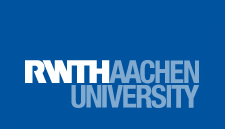Kategorie: ‘Roboter’
IMBA training for the IIDEA project team
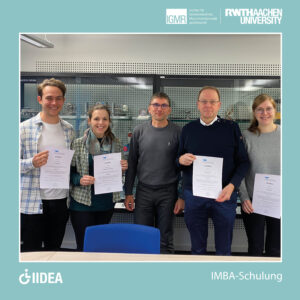
Our IIDEA-project team took part in a training course on the “Integration of people with disabilities into the world of work” (IMBA).
IMBA is positioned at the interface of medical and occupational rehabilitation and enables a precise description and comparison of work requirements and human abilities. The training covered the basics of IMBA, with a particular focus on the defined characteristics that serve as the basis for the assessment of work requirements and abilities. A highlight of the training was the introduction to the “Marie Plus” software, which is closely linked to the IMBA concept. The training was conducted by Torsten Alles, Ph.D., Managing Director of iqpr. His extensive knowledge and experience helped to emphasize the importance of IMBA in occupational therapy and activity-based medical rehabilitation.
We are convinced that this training will support our previous research and make a valuable contribution to the IIDEA project. We are grateful for the expertise we have gained through this training and look forward to applying the acquired knowledge in our daily work.
contact person:
Mathias Hüsing
Carlo Weidemann
Elodie Hüsing
Sophie-Charlotte Keunecke
Christina Jansen
Development of an active dynamic balancing unit for pick and place applications
https://youtu.be/AapssdrPeMQ?feature=shared
Delta robots are the most common parallel robots for manipulation tasks. In many industrial applications they must be operated at reduced speed or dwell times have to be included in the motion planning, to prevent frame vibrations. As a result, their full potential cannot be realized. To address this problem, this we developed the mechanical and control design of an active dynamic balancing unit for reduction of frame vibrations. In this video you can see the experimental validation of this system in a pick and place scenario. It the proposed active dynamic balancing unit provides a significant vibration reduction of about 85% for translational and 78% for rotational vibrations. The experiments were conducted on a low cost Delta robot called the Suisui Bot designed at the IGMR, in collaboration with the Tokyo Institute of Technology. Two different strategies have been proposed for the control of the balancing unit. In this video you can see the IMSC in combination with a open-loop control based on the robots inverse dynamics. Please refer here for further information on the design and control system.
contact: Christian Mirz
The Service Center for Advanced Robotics at IGMR is your pioneer for innovative automation projects
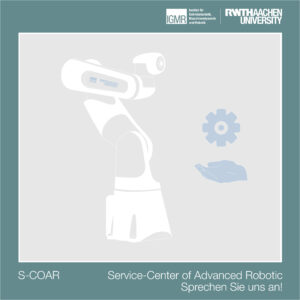
Ideas and support for automation in various specialist areas
Dr. Markus Schmitz is your contact for the implementation and planning of automation projects and for technical advice. Please send requests for quotations to scoar@igmr.rwth-aachen.de.
Exploration of Automated Capability Estimation for Human-Robot Teaming
Der an dieser Stelle eingebundene Inhalt führt Sie auf Seiten, die von der von Google betriebenen Seite YouTube - YouTube, LLC, 901 Cherry Ave., San Bruno, CA 94066, USA - zur Verfügung gestellt werden. Mit dem Aufruf des Inhalts kann YouTube Ihre IP-Adresse und die Sprache des Systems, sowie verschiedene browserspezifische Angaben ermitteln. Wenn Sie in Ihrem YouTube-Account eingeloggt sind, ermöglichen Sie YouTube, Ihr Surfverhalten direkt Ihrem persönlichen Profil zuzuordnen. Dies können Sie verhindern, indem Sie sich aus Ihrem YouTube-Account ausloggen. YouTube verwendet Cookies und Tracking-Tools. Die Datenverarbeitungsvorgänge sowie die Zwecke der Verarbeitung können direkt bei YouTube erfragt und eingesehen werden.
In our Human-Robot Teaming group, we have a vision that humans and robots will one day be able to work together seamlessly and intuitively in a kind of human-machine symbiosis. Recently, we implemented an exploration application to demonstrate the potential of human-robot teams. The exploration includes a human capability assessment system to evaluate human potential and derive appropriate robot actions.
In the future, robots will be able to use the identified capability deltas to find gaps between human performance and the requirements of the work process. Based on these deltas, actions will be derived that do not take work away from humans, but instead increase human capabilities until the requirements are met. Such systems will enable the human-robot team to reach a state that is similar to what is called “flow”.
contact:
Carlo Weidemann
Project launch IIDEA – Inclusion and integration through cobots on the labor market
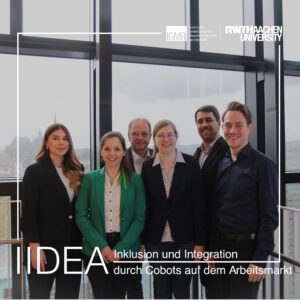
In April, the innovative project “IIDEA – Inclusion and integration through cobots in the first labor market” was launched, which aims to empower the inclusion and integration of severely disabled people in the first labor market through collaborative robotics.
The deployment of cobots makes it possible to create new jobs and forms of work that satisfy the individual needs of severely disabled people. These new forms of work are not being established on the margins but at the heart of digitization and Industry 4.0.
In a rapidly changing world, we must focus on the needs of all people and ensure that everyone can reach their full potential. The IIDEA project is an important step towards an inclusive and inclusive society and economy.
For more information about the project, please visit the project profile. If you have any further questions, please feel free to contact our staff: iidea@igmr.rwth-aachen.de.
Contacts:
Prof. Mathias Hüsing
Carlo Weidemann
Sophie-Charlotte Keunecke
Elodie Hüsing
Christina Jansen
German Robot System Integration Championship 2022
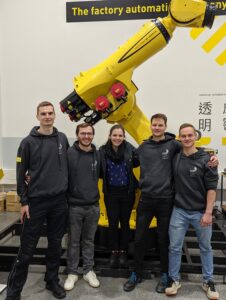
Once again IGMR successfully participated in the German Championship (formerly the Olympics) in Robot System Integration at FANUC Germany!
This year’s task was the variable loading and palletising of boxes. In addition to the independent design of the entire cell, both real and virtual, the implementation also included the digital drawing of components, the setting of safety functions, error detection, user friendliness and instructions, as well as the integration of sensors, actuators and cameras.
Simon Strauch and Florian Menz competed under the team name “IGMR“, while Frederick van Kerkom and Sebastian Polzin took part as the “RWTH“ team. They were accompanied by former participant Sophie Charlotte Keunecke as their coach.
The four students have been working independently with the FANUC Education Cell in the IGMR in their free time over the past few months, learning TP programming and simulation in RoboGuide. The effort was worth it!
Team IGMR presented a very impressive real and virtual Cell installation, implementing every menu option for customer convenience and error handling.
Team RWTH achieved the fastest lap times in both timings with 57 seconds and shone with a very detailed simulation and documentation. We are very proud of all four participants for their great performance!
A special thanks to FANUC Germany for the great implementation and the exceptional cooperation.
The FANUC Education Cell is an essential part of the practical teaching of robotics and offers students the opportunity to try out the handling of industrial robots and the use of frames (coordinate systems) and to carry out or verify their own experiments and measurements.
Contact: Sophie Charlotte Keunecke
Programming courses with the FANUC Education Cell and RoboGuide
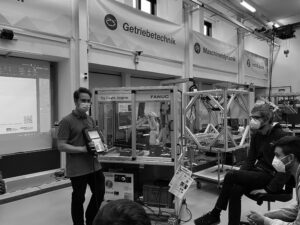
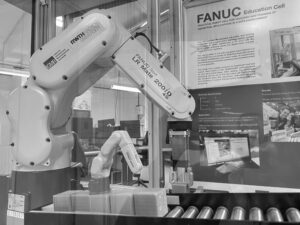
One of the key factors in working with robots at the IGMR is not only the theoretical consideration, calculation and optimisation of movement or mechanics, but in particular the practical work and handling of the systems, as well as the various programming tasks. The FANUC Education Cell is at the heart of this practical teaching, and is also an integral part of the Robotic Systems lecture and robotics courses at the International Academy. In addition to the lectures, the IGMR, represented by Carlo Weidemann, winner of the FANUC Olympiad 2020, also offers internal user courses for employees and gives them the opportunity to work independently on the cell.
Are you a student at the RWTH and interested in working with robots such as the FANUC LR Mate 200iD 4S or carrying out projects? Perhaps you have a concrete idea for a thesis involving the robot? Then please contact us. We look forward to hearing from you!
Contacts:
Carlo Weidemann
Sophie Charlotte Keunecke
First movement of PARAGRIP with new control unit
PARAGRIP’s control architecture has been completely redesigned in order to be fully equipped for its future tasks in multidirectional additive manufacturing (MDAM) with arc welding (WAAM). The movements of all four arms can now be planned, simulated and executed on the real robot using MoveIt in ROS2. The joint positions of the physical robot are always fed back to ROS2, allowing the integration of online planning algorithms in the future. The video shows the planning and execution of a simple test motion of the PARAGRIP.
More information about the project can be found here.
Contact: Jan Wiartalla
IGOR – our in-house robot
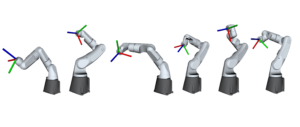
Markus Schmitz
